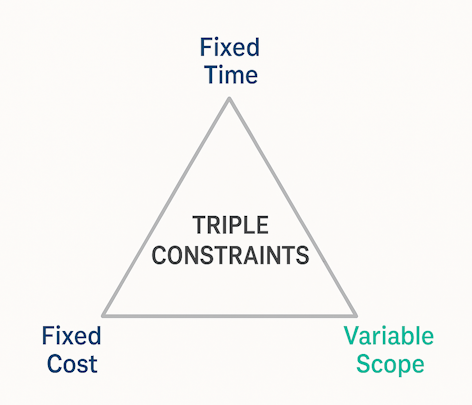Triple Constraints
"In Agile, we fix time and cost and let scope emerge." 1

The concept known as the Triple Constraints - time, cost, and scope - originated in traditional project management and defines three interdependent factors that influence the outcome of any project. In Agile environments, this concept still applies, but the interpretation shifts. Agile challenges the rigidity of these constraints by promoting flexibility and value delivery over fixed plans. Instead of treating all three variables as locked, Agile teams often fix time and cost (through timeboxes and stable teams) and allow scope to emerge. This shift empowers teams to focus on delivering the most valuable work within sustainable limits, adapting based on continuous feedback and evolving understanding.
Impact on Agile Teams
When Agile teams fail to address the interplay of scope, time, and cost, they risk overpromising, burning out, or delivering low value. The misunderstanding of how these variables trade off leads to unrealistic expectations and ineffective planning.
- Fixed Scope, Variable Time and Cost:
- Traditional project mindset.
- Teams are expected to deliver a set backlog.
- Leads to increased cost (e.g., overtime, added people) or extended timelines when complexity increases.
- Fixed Time and Cost, Variable Scope:
- Agile preferred model.
- Timeboxes (like sprints or releases) and team capacity are fixed.
- Scope is adjusted based on value, readiness, and learning.
- Fixed Time and Scope, Variable Cost:
- Sometimes used in high-stakes deadlines or contracts.
- Requires adding resources or paying a premium, often unsustainable.
- Introduces risk of reduced quality or burnout.
Scenario
A mid-sized product team commits to delivering a new user-facing feature by the end of the quarter, with a fixed release date and a set budget. Leadership also mandates that a complete feature set from the initial vision must be included, despite increasing technical complexity. As development progresses:
- Stories become more complex than estimated.
- Integration issues delay progress.
- Testing and UX refinements are deprioritized to hit the deadline.
Despite the team's efforts, the result is a rushed, brittle product with low adoption and growing technical debt. Post-mortem analysis reveals that no one considered adjusting the scope or timeline when problems surfaced, and the team was caught in a trap of conflicting fixed constraints.
To move forward, the team begins using rolling-wave planning and backlog refinement to re-evaluate scope every Sprint.
Ways to Mitigate:
Agile coaches can guide organizations to shift from rigid project thinking toward adaptive delivery. This involves making one constraint flexible while stabilizing the other two.
- Set Guardrails:
- Fix time (e.g., Sprint length, release cadence).
- Fix cost (e.g., team size, working hours).
- Let scope evolve through prioritization.
- Educate Stakeholders:
- Promote iterative forecasting instead of fixed project plans.
- Share visual burnups, velocity trends, and cumulative flow diagrams.
- Encourage Transparency:
- Surface trade-offs early during refinement or planning.
- Use Definition of Ready and Definition of Done to manage scope clarity.
- Promote Systems Thinking:
- Highlight dependencies and feedback loops across delivery teams.
- Avoid local optimization that sacrifices the overall system.
Conclusion:
The Triple Constraints model remains relevant in Agile settings when used to encourage strategic trade-offs rather than rigid planning. Agile teams thrive when they are allowed to adjust scope in response to learning while preserving sustainable pace and stable cost structures. By aligning with business goals and adapting plans collaboratively, teams can deliver better outcomes without sacrificing well-being or quality.
Key Takeaways
- The Triple Constraints model frames the trade-offs between scope, time, and cost.
- Agile favors fixed time and cost, allowing scope to flex for adaptability.
- Misunderstanding constraints often leads to burnout, missed deadlines, or waste.
- Agile teams should manage expectations through frequent refinement and forecasting.
- Transparency, education, and systems thinking help navigate constraint tensions.
Summary
While traditional project management used the Triple Constraints model to enforce delivery certainty, Agile reframes it to support flexibility and value delivery. By consciously choosing which variables to fix and which to evolve, Agile teams protect their pace, improve quality, and stay aligned with customer needs. The key is not eliminating constraints, but learning to navigate them with clarity and shared ownership.